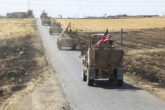July 17, 2014
Iran's Highly Enriched Bargaining Chip
As talks over Iran's disputed nuclear program enter the home stretch, Tehran has placed a major obstacle in the way of a diplomatic solution: insistence on an industrial-scale uranium enrichment program. On July 15 in Vienna, U.S. Secretary of State John Kerry and Iranian Foreign Minister Javad Zarif acknowledged that significant gaps remained between the parties. It now seems almost certain that negotiations will have to be extended for several weeks or months beyond the original July 20 deadline to conclude a comprehensive agreement. But putting extra time on the clock won't make much difference unless Iran is willing to make real concessions on the enrichment issue.
On July 7, in a major speech in Tehran, Iran's supreme leader, Ayatollah Ali Khamenei, the ultimate "decider" on the nuclear issue, declared that Iran has an "absolute need" of 190,000 "separative work units" (SWUs) for its nuclear program. This highly technical term represents a measure of the productive capacity of Iranian centrifuges, the cylindrical machines used to enrich uranium to fuel nuclear reactors -- or, potentially, nuclear bombs. Iran currently operates around 10,000 first-generation "IR-1" centrifuges, has installed another 8,000 IR-1s, and has installed but is not yet operating 1,000 more advanced "IR-2m" models. When the efficiency of these machines is calculated, Khamenei's stated goal for Iran's program would represent a ten- to twentyfold increase in Iran's current enrichment capacity.
A program that large could theoretically provide an indigenous supply of fuel for nuclear power plants, Tehran's stated intention. But it could also allow Iran to rapidly "break out," racing to produce bomb-grade uranium so quickly that the international community couldn't stop it.
More from CNAS
-
The Axis of Upheaval
The West has been too quick to dismiss the coordination among China, Iran, North Korea, and Russia....
By Andrea Kendall-Taylor & Richard Fontaine
-
Proxy battles: Iraq, Iran, and the turmoil in the Middle East
Since Hamas’s attacks sparked the war in Gaza on 7 October 2023, a dangerous cycle of escalation has played out across the Middle East. Iran and its proxies – such as the Hout...
By Hamzeh Hadad
-
What Comes Next for the U.S. in the Middle East
Following a fatal attack on U.S. troops in Jordan, Jonathan Lord analyzes what comes next for the U.S. Watch the full interview with NBC News....
By Jonathan Lord
-
Biden Needs to Deal with China’s Ever-Closer Ties to Iran
Iran and China’s growing relationship is no longer a “what-if,” but a “what-do-we-do-now.”...
By Arona Baigal & Kiana Alirezaie




